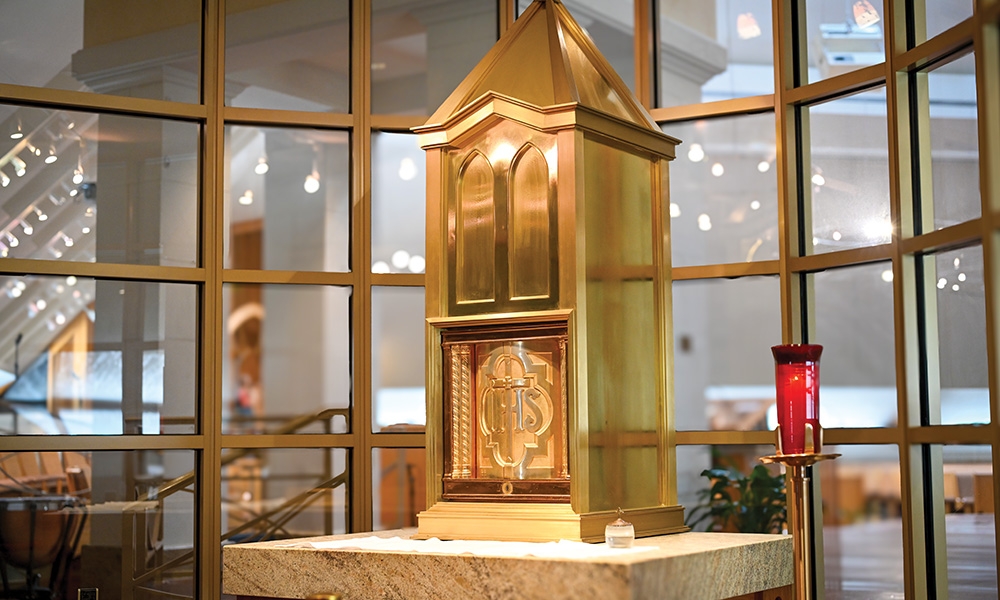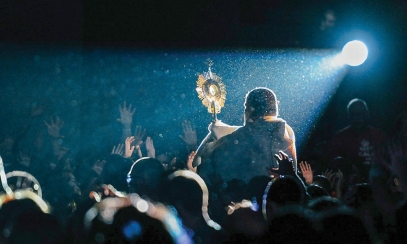
Sharing Jesus: Six simple ways to deepen Eucharistic reverence
Getting your Trinity Audio player ready...When I first heard that the Bishops of the United States were asking us to enter a Year of Mission to conclude the National Eucharistic Revival, I thought, “When will I ever find time to go on a ‘Year of Mission’? And what does that even mean?”
When I first heard that the Bishops of the United States were asking us to enter a Year of Mission to conclude the National Eucharistic Revival, I thought, “When will I ever find time to go on a ‘Year of Mission’? And what does that even mean?”
I suppose I could have embarked upon this Year of Mission by grabbing a bullhorn, finding a corner of downtown Tampa, and reading aloud St. Thomas Aquinas’ section of Eucharistic theology in the Summa Theologica. Yet I would contend that the third year (the Year of Mission) invites us to a much less daunting demonstration of Eucharistic belief: How do I live what we believe as a Church?
With this in mind, I present six ways of living Eucharistic reverence at Mass:
Observe the Eucharistic Fast
As the standard prerequisite to receive Holy Communion, a young child must distinguish between the Eucharist and other, more ordinary food. According to the Catechism of the Catholic Church, anyone seeking to receive Holy Communion at Mass must fast for at least one hour prior to the reception of Communion; this calls to mind that the Eucharist exists as substantially different food. (CCC 1387)
Dress Accordingly
Imagine receiving an invitation to visit the home of the most important person in the world. What would you wear? At every Mass, God invites us home. How do I dress? While recognizing that some might have the means to dress more finely than others, each person attending Mass should nonetheless choose his or her Sunday best: “Bodily demeanor (gestures, clothing) ought to convey the respect, solemnity, and joy of this moment when Christ becomes our guest.” (CCC 1387)
Arrive Early
When do I arrive for Mass? Do I allow myself (and, if applicable, my family) at least a small amount of time to recollect and determine personal prayer intentions before Mass begins? Or do I frequently count myself among the “buzzer beaters” who arrive while the priest processes down the main aisle?
Genuflect
When I arrive at the church, do I acknowledge Jesus’ presence in the tabernacle? After all, the red sanctuary candle (when lit) reminds us of Jesus’ Real Presence. If I can genuflect, do I genuflect fully? If my legs no longer work as well as they used to (it happens!), how might I make the most appropriate action to still acknowledge Jesus’ Eucharistic presence in the tabernacle (perhaps with a profound bow)?
Receive in a State of Grace
If I am conscious of unconfessed serious sin (what we call mortal sin), do I appropriately refrain from receiving Holy Communion until I receive absolution in the sacrament of penance? St. Paul once wrote the following to the Christians in Corinth: “Therefore whoever eats the bread or drinks the cup of the Lord unworthily will have to answer for the body and blood of the Lord. A person should examine himself, and so eat the bread and drink the cup.” (1 Cor 11:27-28)
Remain after Receiving Communion
Except for a serious medical emergency or for those bringing Holy Communion to the sick and homebound, no excuse validates departing Mass before the final blessing. To those who respond that leaving early helps them get ahead of parking lot traffic or avoid the priest’s announcements (or even, for some, his second, post-Communion homily!), I would offer these moments as beautiful opportunities to embrace Jesus’ example of sacrifice. After all, He sacrificed everything to bestow upon us the gift of the Eucharist.
The National Eucharistic Revival was launched on June 19, 2022 by the U.S. Conference of Catholic Bishops (USCCB).
The Bishops of the United States called for a three-year grassroots revival of devotion and belief in the Real Presence of Jesus in the Eucharist. They believe that God wants to see a movement of Catholics across the United States, healed, converted, formed, and unified by an encounter with Jesus in the Eucharist — and sent out in mission “for the life of the world.”



